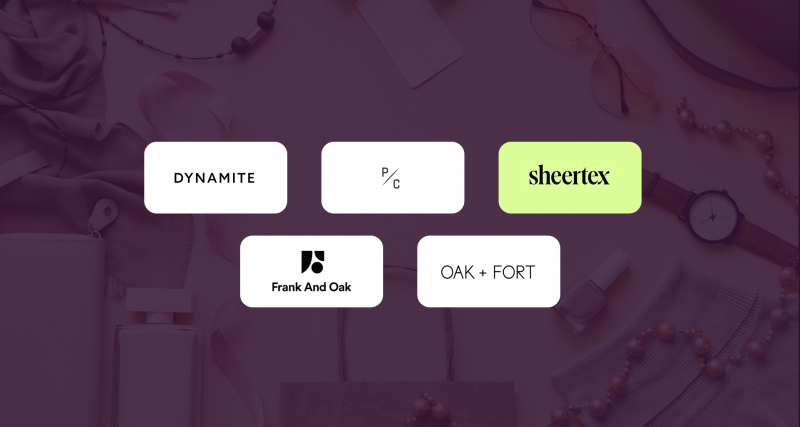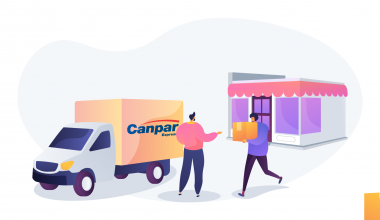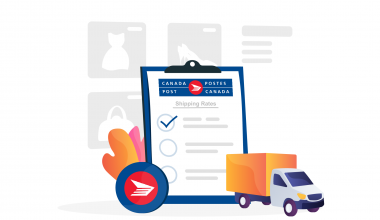Fashion is moving dangerously fast today, and so is the trend of instant gratification. D2C fashion brands must keep up with the consumer’s demand for speed and convenience to stay in the game. When the customer spots that “must-have” item on social media, they don’t want to wait.
Especially when it comes to fast fashion in Canada, the expectation for online fashion orders is getting seriously speedy: the average shopper now expects delivery in a mere 2-4 days. If it takes any longer, they are likely to abandon your cart and click away to a competitor.
And while this is an imposing challenge, it is also a huge opportunity. Canadian fashion brands have mastered same-day, next-day, and 2-day delivery options, registering loyal customers by the thousands. How? It all comes down to smart shipping strategies and hyper-efficient e-commerce fulfillment.
The Canadian Fast Fashion Boom
It was back in 2016 that the scales had started tipping towards online shopping compared to brick-and-mortar stores, changing the vagaries of shopping experience, demand, and speed. The development came almost parallelly with social media’s colossal overtake of our lives.
Today, Gen Z and Millennial shoppers demand trendy fast fashion that’s viral on social media. They want clothes that everyone is talking about, and they want them without long waits. This constant desire for “what’s new” means Canadian fashion brands must turn around designs and get them to your closet super-fast.
On the one hand, this speed race has fuelled the growth of D2C (direct-to-customer) online clothing stores over traditional ones. D2C brands sell directly to the consumer online, cutting out the middleman. They can react to trends much faster, offer competitive prices, and control the entire Canadian online shopping experience from click to delivery.
The numbers speak for themselves. The Canadian fashion scene is exploding, with fashion e-commerce sales projected to hit a whopping $13.6 billion by 2026. It is not just the multi-billionaire companies that are endorsing free shipping today. Smaller, homegrown retailers have also made their moves with fast-fashion, faster shipping to meet consumer demands:
1. Dynamite / Garage
Veterans in fast fashion in Canada, Dynamite / Garage stands out with its trendy, youth-oriented collection that hits all the right notes for a quick fashion fix. They understand what their customers want, and they get it to them fast.
2. Peace Collective
Beyond just cool clothes, Peace Collective blends fashion-forward designs with a cause-driven vibe. Their loyal customer base is excited to support a good cause with every purchase, all while getting their order swiftly.
3. Sheertex
Sheertex is among high-growth D2C fashion brands in Canada that has built a reputation for innovative, super-durable hosiery. They back it up with a commitment to premium shipping for prompt delivery.
4. Frank And Oak
Eco-conscious style that doesn’t sacrifice speed is what Frank And Oak delivers. They blend environment-friendly practices with efficient logistics, proving sustainable shipping fashion is a viable option for Canada’s fashion-lovers.
5. OAK + FORT
Known for their elevated basics and minimalist aesthetic, OAK + FORT has built a strong online presence. With their fulfillment game locked down, the brand ensures an impressive order-to-door speed for customers.
One thing is clear: the demand for fast fashion has changed both how customers shop and how businesses operate. Leading the Canadian fast fashion race is not just about great products anymore – you must pair it up with top-of-the-line shipping speed. This makes shipping for fashion e-commerce a major differentiator.
Shipping Speed as a Differentiator
Fast shipping is more than just a convenience today for the customer. It is a huge factor in their decision-making when it comes to online shopping.
Why so?
For one, shipping speed is a powerful differentiator for customer loyalty.
69% of Canadian online shoppers report that fast shipping directly influences their brand loyalty.
This means fast shipping can drive top-of-funnel purchase decisions for retailers of all sizes. More than just building sales, competitive fulfillment can build a lasting relationship with your customer base.
Another big reason is what we can call “The Amazon Effect”. Amazon Prime’s launch in 2005 came with “an indulgent luxury”, in Jeff Bezos’ own words, with 2-day delivery. This changed customer habits forever, conditioning them to expect 1-2 day delivery not as a novelty but the norm, a standard expectation.
The customer’s expectations for fast shipping are no different for large or small or mid-sized brands, and it is quickly becoming an expected standard. Now, even smaller, independent Canadian fashion brands must indirectly compete with Amazon’s formidable logistics network to survive and grow.
With the pressure on, major Canadian fashion brands are actively promising 2-day delivery, especially within urban hubs like Toronto, Montreal, and Vancouver. Only those that consistently deliver on this promise will be the ones to capture and retain market share.
Brands are implementing various strategies to keep up:
- Optimizing the e-commerce fulfillment workflow with features like express checkout,
2. Using advanced apparel logistics solutions for auto-routing to the closest warehouse, and
3. Minimizing order-to-door time with ground shipping or air freight, as the situation demands.
Let’s look deeper into this.
Behind the Scenes: How Fast Fashion Brands Fulfill at Speed
Distributed Fullfilment centres
One of the most impactful strategies for fast fashion brands is the strategic use of distributed fulfillment centres across Canada. Instead of relying on a single warehouse, brands are establishing distribution centres in key regions, dramatically reducing the “last-mile delivery” time by positioning inventory closer to major population centres.
An order from Vancouver doesn’t need to travel all the way from Toronto, for instance, cutting days off transit.
Same day Pick and Pack, Ship
Efficiency comes next. Brands are implementing rigorous processes for same-day pick and pack, and ship. This requires optimized warehouse layouts, efficient picking methods like batch or zone picking, and integrated software systems that instantly relay orders to the fulfillment floor.
Pre-packing bestsellers is further helping brands shave off precious minutes per order. Items that are consistently high-volume sellers may be partially or fully pre-packed during slower periods. So when an order comes in, it’s already ready to go.
3PLs to rescue
More importantly, many Canadian fashion brands are not managing this complex logistics operation entirely in-house. They take help from 3PLs to handle warehousing, inventory management, order fulfillment, and carrier management. This helps brands leverage the existing infrastructure, expertise, and carrier relationships of warehouse partners without any massive capital investment or operational headaches.
For instance, shipping partners like ShippingChimp have the right technology and processes in place to handle high volumes, manage multiple fulfillment locations, and integrate seamlessly with your brand’s e-commerce platform. With their network and smart routing capabilities, ShippingChimp makes 1-2 day deliveries possible across all major cities in Canada.
What does this mean for brands? They get to focus on their core competencies – design, marketing, sales – while leaving the complex, time-sensitive fashion logistics to experts.
Packaging that Keeps Pace with Fashion
While you are pushing for speed in fashion e-commerce, every detail matters, and packaging is no exception.
A primary consideration is the use of lightweight, compact mailers.
Think poly mailers instead of bulky boxes for items like t-shirts, leggings, or soft accessories – a small choice with a huge impact, because lighter packages mean cheaper shipping costs, less space in transit, and fast delivery of clothing in Canada on less loaded trucks.
And for those struggling to balance aesthetics with efficiency, branded poly mailers are a good alternative.
You get all the benefits of a mailer with the opportunity for brand visibility and a memorable unboxing experience. Many fast fashion brands are picking branded mailers over custom boxes to prioritize speed over rigidity.
Reusable and resealable packaging for returns is another brilliant strategy, given returns take up a significant portion of the fashion e-commerce funnel. They are convenient for the customer (the return process becomes smoother for them), reinforce your brand’s commitment to sustainability, and reduce customer friction.
Managing Returns Without Losing Momentum
Another challenge is high return rates in fast fashion, often soaring up to 30% of all sales. Returns are more than just a cost centre for brands – they are a critical touchpoint that can either build or break customer loyalty. Losing momentum in this phase means losing revenue and customer trust.
This is where leading Canadian fashion brands are taking back control.
Simplify the returns process
The first step is simplifying the returns process for customers, eliminating friction at every step. Think scannable QR codes that link directly to a return portal or prepaid return labels included in the package, making returns as hassle-free as possible.
Dynamic returns window
Brands are also putting in place sophisticated internal workflows like dynamic return windows for more flexibility, so return windows are different for different product types or loyalty statuses.
Revisit Inventory workflows
There’s a strong focus on streamlining inventory restock workflows – quick inspection, re-tagging (if necessary), and getting back to available inventory as fast as possible. The quicker a returned item can be resold, the less likely it is to be marked down, which could potentially cut down revenue loss.
Final Takeaway: Dress Fast, Ship Faster
Speed is no longer an option for Canadian fast fashion. It is an absolute expectation. With the “Amazon Effect” setting a new benchmark, consumers anticipate rapid delivery from every brand, no matter how big or small, how old or new. The demand continues to grow, whether or not supply chains are ready for this abrupt shift.
What does this mean for your fashion brand? Your shipping strategy is now just as critical as your latest collection or marketing campaigns. Consistent fast shipping holds the potential to convert first-time buyers into loyal, repeat customers, reinforcing trust, building confidence, and taking cart abandonment down several notches. All things summed up, it is the final, tangible touchpoint that cements your brand reputation.
Want to keep your shipping as fast as your fashion drops? ShippingChimp helps Canadian apparel brands deliver with confidence.
FAQs
Q1: Why is shipping speed so critical for fashion brands in Canada specifically?
Ans: Canadian consumers, especially Gen Z and Millennials, now expect fast delivery, often within 2-4 days. This expectation is driven by large retailers and influences brand loyalty. Meeting these rapid delivery times is no longer a luxury but a fundamental requirement to convert sales and retain customers in a competitive market.
Q2: What is “The Amazon Effect” and how does it impact my Canadian fashion brand?
Ans: “The Amazon Effect” refers to how Amazon’s 1-2 day delivery standards have reshaped consumer expectations across the board. This means that even independent or smaller Canadian fashion brands are now implicitly benchmarked against these rapid delivery times. Failing to meet similar expectations can lead to customer dissatisfaction and lost sales.
Q3: How can my brand achieve 2-day delivery across major Canadian cities?
Ans: Achieving rapid delivery often involves strategic changes. Begin by setting up distributed fulfillment centers closer to urban hubs. Next, optimize your internal processes for same-day shipping, and explore technologies like shipping automation. Partnering with a shipping carrier like ShippingChimp can help tremendously.
Q4: What role does packaging play in fast fashion shipping?
Ans: Packaging is crucial for both speed and cost-efficiency. Use lightweight, compact mailers o reduce shipping costs and transit times. While balancing aesthetics with efficiency is key, branded poly mailers can offer a good compromise. Additionally, you may incorporate reusable or resealable features can streamline the customer’s return experience.
Q5: How can brands effectively manage returns without losing sales momentum?
Ans: Returns can be high in fashion retail, which makes it important to simplify the process for customers. Implement customer-friendly solutions like scannable QR codes for easy return initiation and provide prepaid return labels. You can also focus on dynamic return windows and efficient inventory restock workflows internally to get returned items into sellable stock as quickly as possible.
Q6: What is a 3PL, and when should a fashion brand consider using one?
Ans: Brands should consider a 3PL when scaling, facing logistical complexities, or wanting to leverage expert infrastructure to achieve faster, more cost-effective, and reliable delivery, allowing them to focus on core business operations like design and marketing.
- Why Winter Shipping Is a Big Deal for D2C Cosmetics Brands? - December 18, 2025
- The Last Minute Customer Strategy: Handling Orders After the Carrier Cut-off - December 12, 2025
- Holiday Shipping Deadlines 2025: When to Ship for On-Time Christmas Delivery - December 3, 2025






